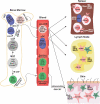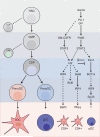Transcription factor networks in dendritic cell development
- PMID: 21924924
- PMCID: PMC4010935
- DOI: 10.1016/j.smim.2011.08.009
Transcription factor networks in dendritic cell development
Abstract
Dendritic cells (DCs) are a heterogeneous population within the mononuclear phagocyte system (MPS) that derive from bone marrow precursors. Commitment and specification of hematopoietic progenitors to the DC lineage is critical for the proper induction of both immunity and tolerance. This review summarizes the important cytokines and transcription factors required for differentiation of the DC lineage as well as further diversification into specific DC subsets. We highlight recent advances in the characterization of immediate DC precursors arising from the common myeloid progenitor (CMP). Particular emphasis is placed on the corresponding temporal expression of relevant factors involved in regulating developmental options.
2011 Elsevier Ltd. All rights reserved.
Figures




References
-
- Birnberg T, et al. Lack of conventional dendritic cells is compatible with normal development and T cell homeostasis, but causes myeloid proliferative syndrome. Immunity. 2008;29:986–997. - PubMed
Publication types
MeSH terms
Substances
Grants and funding
LinkOut - more resources
Full Text Sources
Other Literature Sources

